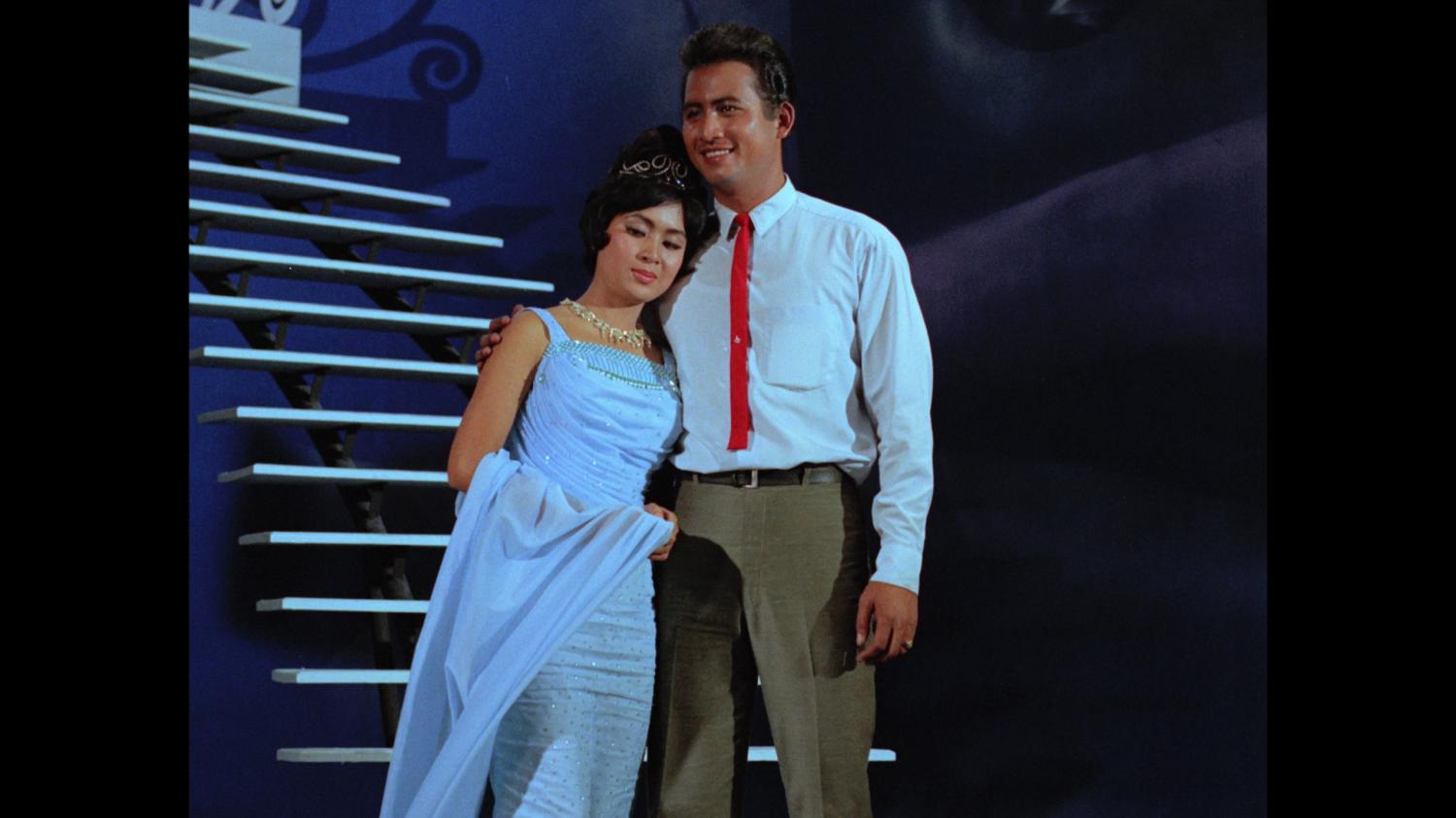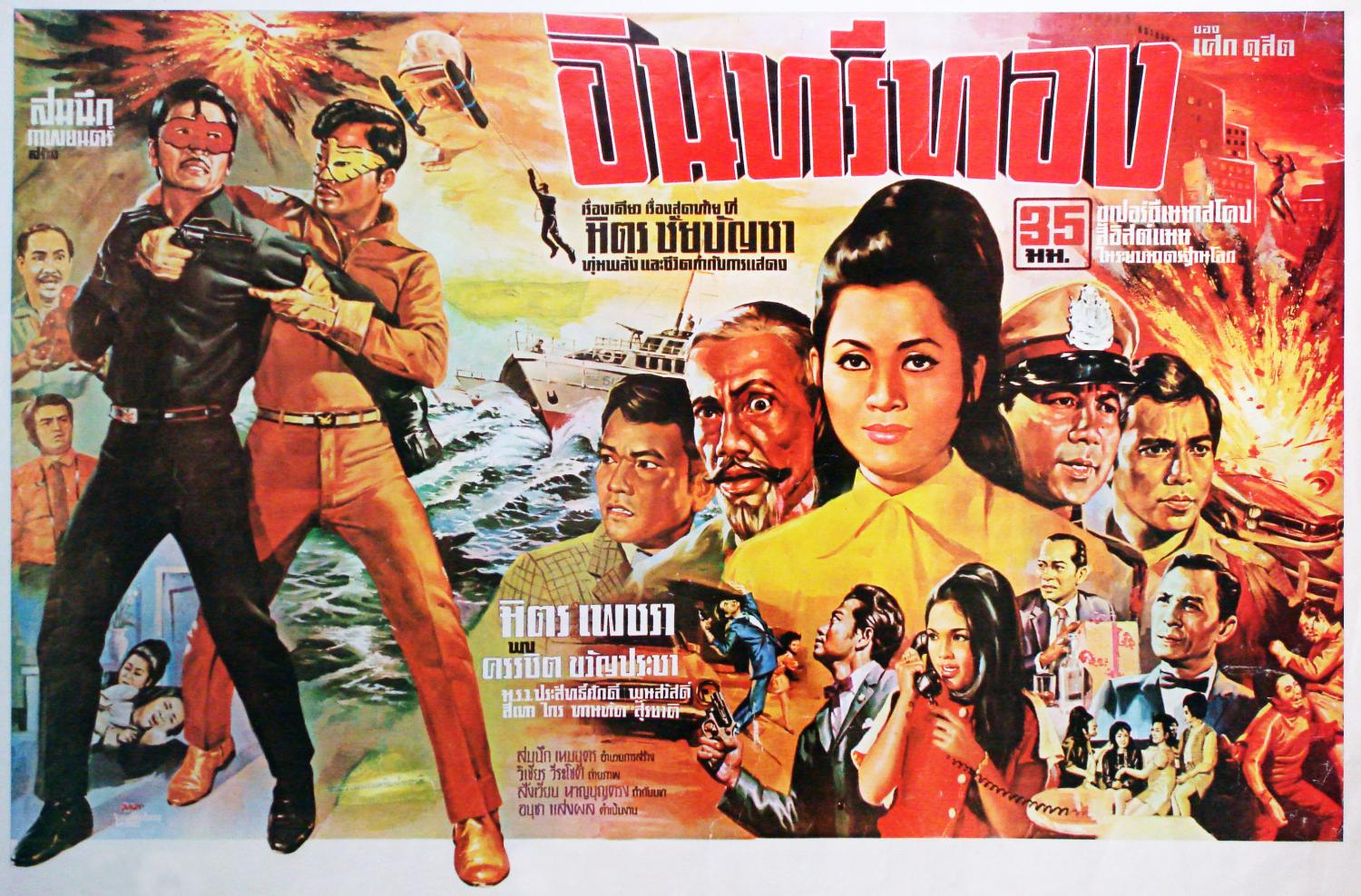In an abrupt moment of life's brutal script, Mitr Chaibancha fell to his death from a helicopter ladder on Oct 8, 1970. He was filming Insee Thong (Golden Eagle), playing an anti-communist masked hero, when he slipped from the rung and plunged to the ground in Pattaya. That same evening, his body was transported to Wat Kae Nang Loeng. Thousands of people, unable to believe that Thailand's most famous actor was really, tragically dead, amassed impromptu at the temple and demanded that his corpse be raised from the coffin and shown to the public.
A gasp of shock and disbelief, a look of horror and incredulity -- cut to black. When the light came back on, Thai cinema has never been the same since.
This weekend, the anniversary of Mitr's death will be remembered in a handful of events. At the Hua Lamphong train station tomorrow, the Bangkok Outdoor Cinema Festival will screen Torachon Khon Suay (Operation Revenge, 1967), starring Mitr as a dashing secret agent. On Sunday the festival will screen October Sonata (2009), a decade-spanning romantic drama in which the scene of Mitr's body arriving at Wat Kae after his fatal fall sets off a chain of bitter events.
Also on Sunday, the Thai Film Archive in Salaya will present a programme of specially curated musical sequences featuring Mitr and his co-stars from the late 1960s. All films have been digitised from 35mm prints, ripe with colour and sound.
Then, with the loudest fanfare, next Wednesday Netflix will debut the film Monrak Nak Pak (Once Upon A Star), a platform original that hinges on a chapter of Thai movie history and on Mitr's popularity. Directed by Nonzee Nimibutr, the film tells the story of a troupe of soundtrack dubbers in 1970 who roam the countryside with their mobile film truck to set up outdoor screenings and perform live-dubbing for stars that appear on the screen, including Mitr.

Torachon Khon Suay (Operation Revenge).
Fifty-three years after his death at the age of 36, Mitr Chaibancha lives on in the movie-afterlife. He lives on in film archives, naturally, but also as a memory constantly recontextualised by shifting technology, a meta-cinematic mythology dead and reborn time and again through 16mm, 35mm and streaming eras. The event at the Thai Film Archive on Sunday and the launch of the Netflix film in particular present an opportunity to revisit Mitr, a titan of the big screen, and how the industry that gave birth to his screen presence has transformed over the years.
Mitr acted in his first film, Chart Sua, in 1958, and rose to stardom a year later in the role of the crime-fighting Red Eagle in the film Chao Nakleng. He would go on to appear in over 300 films, up until his death in 1970. Most of these flicks were shot on 16mm positive film stock with no sound, meaning the footage from the camera could be edited and distributed to cinemas all over the country (and sometimes to travelling projection units) in a quick turnaround. Live-dubbers would fill in the blanks and give voice to the characters onscreen. Known for his tall, vigorous physique, Mitr's real voice totally went unheard due to this standard practice.
The use of 16mm film stock in the decades after World War II was unique to the Thai film industry. By then, the rest of the film world was operating on 35mm, which yielded better picture quality, with sound available, and was also more favourable to preservation and archiving efforts. The cheaper 16mm films were treated like fast-food products made, consumed and forgotten rapidly.
Mitr, and other actors from the period, was known for shooting two or three films simultaneously, driving from one set to another and sometimes working around the clock to satisfy the demand of producers and audiences, in a work routine that would have horrified unionists everywhere. At the same time, the 16mm prints easily wore out after repeated projection, night after night. With no negative sources, most of these films perished beyond salvation before any archivist could intervene.

A scene from Monrak Nak Pak (Once Upon A Star).
Another practice of Thai film directors in the 1960s, however, was to shoot a film in 16mm but switch to 35mm in musical sequences. The idea was to highlight the colourful set pieces full of vibrant colour and sound, in a similar spirit to mid-century MGM productions. These musical interludes, which lend themselves more to archival endeavour, have been put together by the Thai Film Archive in the Mitr commemoration programme this weekend (again, it is not Mitr's real voice in these sequences).
Beloved but lost too soon, Mitr existed on 16mm and 35mm (Operation Revenge, screening at Hua Lamphong on Saturday, was a rare film from the 1960s shot on 35mm). His death in 1970 shook the film industry to its core, triggering a paradigm shift that marked the end of the 16mm era. A few years later, all Thai films would shift to the standard 35mm with sound.
And now with the Netflix-produced Once Upon A Star, Mitr's journey in the afterlife continues onto another "platform".
The trailer makes it clear that the film is not a story about Mitr, but one in which Mitr looms large as a force, a presence, an object of cinema paradiso nostalgia. Sukollawat Kanarot (note his resemblance to Mitr) plays a professional live voice artist and member of a nang kai ya projection unit -- a band of travelling medicine salespeople who wander remote villages to screen outdoor movies while pushing painkillers or bowel-cleansing potions in between film reels (another unique feature in Thai film history). The film also includes a scene in which the protagonist, who has dubbed Mitr's voice, hears news of the superstar's death and the outpouring of public emotion that follows.

A Once Upon A Star hand-painted movie poster in the style of yesteryear. (Photo: NETFLIX)
Dead movie stars fall out of favour -- the final fade-to-black moment. But Once Upon A Star is probably an attempt to find new relevance to outdated cultural specimen and reconnect contemporary audience to Thai cinema history. Unfortunately, the film will not be shown on the big cinema screen, except maybe at a press screening.
Mitr's sweet hereafter exists in pixels rather than grains, in bytes rather than reels, in digital files rather than analogue projection -- a testament to the changing times, technology and taste. Few stars in the annals of Thai cinema have traversed that long and unpredictable course. Mitr is a treasure that somehow keeps on giving, whether on the big or small screen.

Torachon Khon Suay (Operation Revenge). (Photos: Thai Film Archive)
Mitr movies this month
- Torachon Khon Suay (Operation Revenge, 1967), showing as part of the Bangkok Outdoor Cinema Festival at Hua Lamphong Station tomorrow at 6pm. Free admission.
- Insee Thong (Golden Eagle), Mitr's last film, showing tomorrow at Thai Film Archive, Salaya, at 1pm.
- October Sonata (2009), showing as part of the Bangkok Outdoor Cinema Festival at Hua Lamphong Station on Sunday at 6pm. Free admission.
- Mitr In Musical Numbers, showing at Thai Film Archive, Salaya, on Sunday at 2pm. Free admission (go to fapot.or.th).
- Monrak Nak Pak (Once Upon A Star) streams on Netflix from Oct 11.

Lom Huan.


